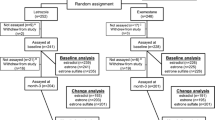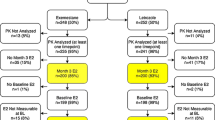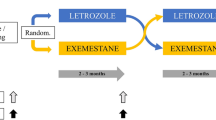Summary
Monitoring effective antiestrogenic activity of the triphenylethylenes in patients with breast cancer is usually determined by the duration of response. The pharmacokinetics of toremifene and tamoxifen have been shown to be highly variable but patient specific. In the present study, we developed a method to accurately assess the antiestrogenic activity of these agents using plasma specimens, cell culture, and cell cycle measurements. Plasma specimens (4–5mls) obtained from patients receiving toremifene (360mg/day for 5 days in a phase I trial) or tamoxifen (20mg/day) were extracted and reconstituted in tissue culture media (4–5mls), and growth inhibition was determined in estrogen responsive MCF-7 cells. Additionally, plasma specimens were quantified for toremifene or tamoxifen concentrations using HPLC. Growth inhibition of plasma specimens containing either toremifene or tamoxifen and their metabolites was also examined. Cell cycle measurements were determined followingin vitro exposure with flow cytometric techniques. Our results show that a dose-response relationship exists between cell growth inhibition and cell cycle measurements for human plasma with added toremifene or tamoxifen, and also for human plasma specimens containing drug and its metabolites after treatment. Our antiestrogenic bioassay can address clinical research problems such as patient-specific pharmacokinetics, dosing compliance, and acquired antiestrogen resistance.
Similar content being viewed by others
References
Jordan VC, Robinson SP, Welshons WV: Resistance to antiestrogen therapy.In Kessle D (ed) Drug Resistance. CRC Press, Boca Raton, 1987.
Fromson JM, Pearson S, Bramah S: The metabolism of tamoxifen (ICI 46,474) in laboratory animals. Xenobiotica 3: 693, 1973.
Wiebe VJ, Benz CC, Shemano I, Cadman TB, DeGregorio MW: Pharmacokinetics of tormeifene and its metabolites in patients with advanced breast cancer. Cancer Chemother Pharmacol 25: 247–251, 1990.
Buckley MM-T, Goa KL: Tamoxifen: A reappraisal of its pharmacodynamic and pharmacokinetic properties and therapeutic use. Drugs 37: 451–490: 1989.
Fabian C, Sternson L, Barnett M: Clinical pharmacology of tamoxifen in patients with breast cancer: comparison of traditional and loading dose schedules. Cancer Treat Rep 64: 765–773, 1980.
Langan-Fahey SM, Tormey DC, Jordan VC: Tamoxifen metabolites in patients on long-term adjuvant therapy for breast cancer. Eur J Cancer 26: 883–888, 1990.
Osborne CK, Coronado E, Allred DC, Wiebe V, DeGregorio MW: Acquired tamoxifen resistance: Correlation with reduced breast tumor levels of tamoxifen and isomerization of trans-4-hydroxytamoxifen. J Natl Cancer Inst 83: 1477–1482, 1991.
Holleran WM, Gharbo SA, DeGregorio MW: Quantitation of toremifene and its major metabolites in human plasma by high-performance liquid chromatography following fluorescent activation. Anal Letters 20: 871–879, 1987.
Krishan A: Rapid flow cytofluorometric analysis of mammalian cell cycle by propidium iodide staining. J Cell Biol 66: 188–195, 1975.
Author information
Authors and Affiliations
Rights and permissions
About this article
Cite this article
DeGregorio, M., Wurz, G., Emshoff, V. et al. A bioassay for antiestrogenic activity — potential utility in drug development and monitoring effectivein vivo dosing. Breast Cancer Res Tr 24, 35–41 (1992). https://doi.org/10.1007/BF01832356
Issue Date:
DOI: https://doi.org/10.1007/BF01832356




